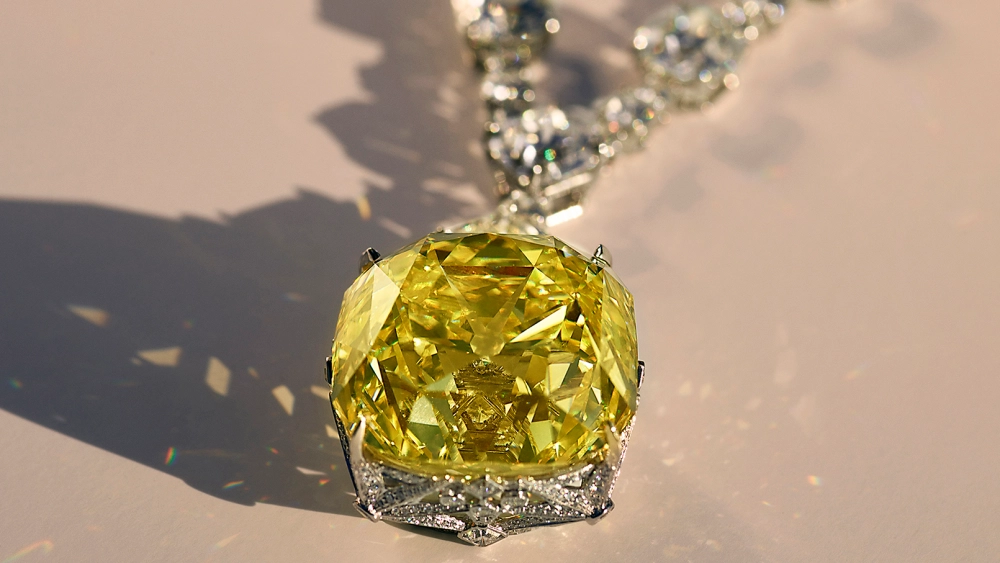Optimal depth and saturation of colour, in addition to remarkable brilliance, fire, and scintillation, are desirable qualities in a fancy intense yellow diamond (or any fancy coloured diamond).
Since white light and light reflecting back toward the human eye both have a neutralising effect on our impression of the diamond’s body colour, these two goals are at odds with one another. An experienced diamond cutter must expertly navigate the tension between these two optical factors in order to create brilliant yellow diamonds of varying shapes and sizes.
The diamond’s distinctive facets can make a big difference in the frequency with which imperfections show up and the value of a yellow diamond of the same colour grade.
- Diamonds Of The Brightest Yellow Shade, Brilliantly Cut
![]()
In terms of fancy diamonds, the Radiant cut is the most sought after. Indeed, this is most pronounced in yellow diamonds. Faceting in the Radiant shape maximises a diamond’s worth by bringing out its full colour saturation while also preserving as much of the stone’s brightness and fire (its “Life”) as possible. Diamonds with a yellow hue, rich tone, and brilliant shine are highly sought for. Radiant cuts range from square to rectangular and are particularly well-suited to yellow diamonds.
- Fancy Yellow Cushion-Cut Diamonds
![]()
Both the Cushion and Radiant cuts share a common goal of maximising a stone’s colour saturation and brilliance through its facets and overall shape. This is why the Asscher cut is the second most popular of all fancy diamond shapes.
The most obvious visual distinction between the Cushion and the Radiant is the Cushion’s softer, rounded edges. The many Cushion cuts of yellow diamonds are sure to impress. When shopping for a yellow diamond, a cushion cut diamond, which can be square or rectangular, is a great alternative.
- Pristine Yellow Diamonds Cut In The Emerald Shape
![]()
Faceting for emerald cutting is done in a series of steps. As a result of the diamond’s system of long, broad facets, the diamond’s return of white light (its Brilliance) is maximised at the expense of the viewer’s ability to perceive the diamond’s true body colour. Consequently, yellow diamonds that are cut in the shape of an Emerald are extremely rare. The price of a yellow diamond cut into an Emerald shape is typically much more than that of a similarly coloured diamond cut into a Radiant or Cushion shape. 
- Diamonds In A Yellow Asscher Cut
Asscher cuts are quite similar to Emerald cuts; neither is the best shape for a yellow diamond, but both can be spectacular. When compared to other fancy colour diamond shapes, the Asscher stands its own because of its distinctive faceting, which creates a fascinating pattern of concentric squares.
- Oval-Shaped, Yellow Diamonds
![]()
Though Oval Brilliant-cut yellow diamonds are prized for their high levels of Brilliance and Fire, which result from their exceptionally well-preserved colour and vivid display, the diamonds’ elongated and asymmetrical shape might provide some difficulties.
Although “bow-tie” sounds nice, it actually refers to a black or colourless area in the centre of the diamond, which is typical in Oval shapes. A close inspection is required to determine the degree of the Oval’s bow. In very well-proportioned Ovals, the bow-tie can be minimised nearly to nothing.
- Radiant-Cut Yellow Princess Diamonds
![]()
Although the Princess cut is commonly used for colourless diamonds, a well-crafted example in a yellow diamond is quite uncommon. Princess-cut diamonds that are yellow often lack brilliance because the faceting design masks the stone’s true colour. Because of its sharp, pointed edges, the Princess can be tricky to set in a ring. If you have your heart set on a square yellow diamond, but are having trouble finding one, we recommend looking into the Radiant cut instead.
- Diamonds Cut In The Shape Of A Pear
![]()
Since the pear form is so different from the oval, it has the potential to exhibit very high Brilliance and “Life” in the stone, all while keeping and showcasing superb colour saturation.
Similar to other asymmetrically shaped diamonds, the degree of ‘bow-tie’ in a given stone can only be determined through a visual examination.
- Yellow Diamonds, Round And Brilliant
![]()
Round Brilliant is the most common and recognisable diamond cut, but there are many more. For nearly a century, experts in the diamond cutting industry have studied how to optimise the diamond’s shape for maximum light return through the use of precision optics. It’s excellent news that their efforts paid off. They have been successful, unfortunately. Since the Round Brilliant shape prioritises sparkle above the diamond’s body colour, yellow diamonds cut in this style often appear pale and disproportionate.
There are, however, diamonds with such a rich colour that they appear to keep their body colour even after being cut into a Round Brilliant shape. Round Brilliant cut yellow diamonds are exceptionally rare and hence fetch a high price.










Comments are closed.